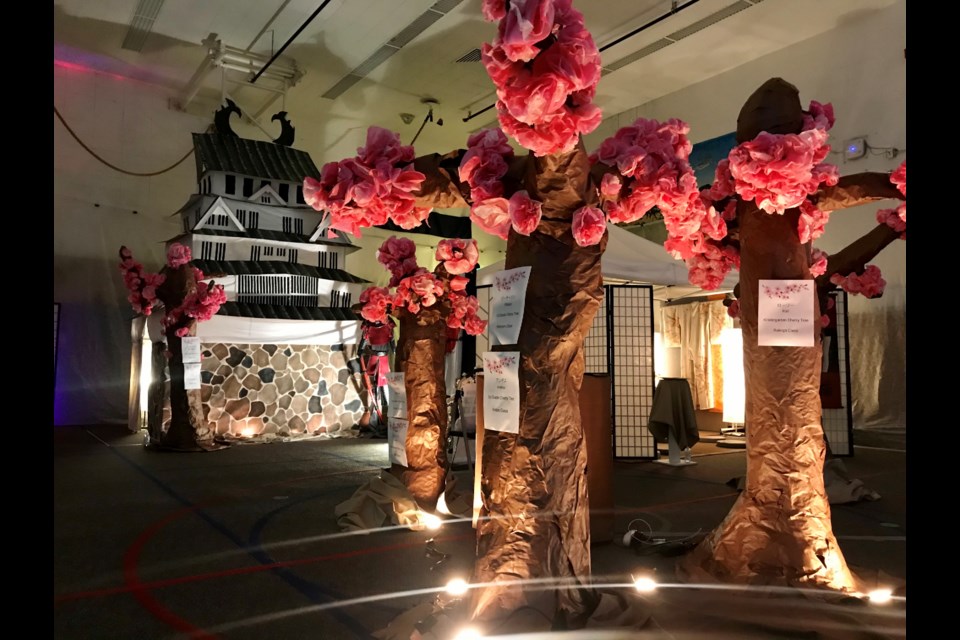On Wednesday, three hundred students, PreK to fifth grade, stepped into a built-up Japan as part of Hygiene Elementary’s tradition to bring the world to the school.
For the past 11 years, the school has selected a place in the world and, once, outer space, to guide a year-long learning for all grade levels that culminates in a final, capstone project towards, according to Principal Renee Collier.
“We have been in Greece, we’ve colonized Pluto, we’ve gone to the ocean. Last year we were in Australia for the wildfires,” she said. “This year it’s Japan.”
The project is a community-building activity that includes all students and staff as well as parents. Together they bring an immersive experience into the culture, history, geography, literature, language, food and arts, she said.
The event last year happened a week before the school closed down because of the COVID-19 pandemic. This year, students and staff are able to continue the tradition with a few stipulations for the safety of the community, according to Collier.
“At the end of the year, parents come in … and transform the school to that location (and) we usually do an open house for our community,” she said. “This year we had to bring it to them virtually. We filmed it for the parents and just have the kids coming through instead.”
Each classroom took turns walking through the school’s gym which was transformed into elements of the Japanese culture and geography.
After showing a handmade passport, students stepped onto the base of Mt. Fuji and walked through a fault line that tests their balance and knowledge of geography. Daring students then climbed the mighty mountain using a rope net while an image of Mt. Fuji was broadcasted on a screen.
“There is a lot of academic material in this event,” Suzy Evans, fourth-grade teacher, said. “They learn about the severity levels of earthquakes … They get to climb Mt. Fuji with the (screen showing a) bullet train image and they learned all about the latest technology of Japan.”
Evans spearheaded the event this year which allowed her to put her education to the test. This year she is working to earn her master’s degree in Learning Design and Technology from the University of Colorado Denver.
She designed a website that housed different choice boards in different content areas for students to gain background knowledge on Japan.
Students walked through a cherry blossom forest, constructed collectively with the help of the parents, according to Evans, before entering the zen garden.
Parents contributed to the staging of the school’s gym by making paper mache cherry blossoms, building eight feet torri arches or tall traditional Japanese gates.
“We talk about the tradition of the zen garden and how you can come in to calm your mind and what the raking is for,” she said. “They get to experience raking themselves. We put patterns on the ground that they can try to copy.”
After learning to calm themselves, students set out for a lesson in origami where they made cranes. Students were also able to grab a photo souvenir in front of a made-to-scale Hamiji castle that sits behind the protection of a traditional samurai armor.
“As they come through the castle, the students will find all the cranes that they made, with the symbol of the 1,000 crane,” she said, adding the 1,000 crane symbolizes good luck.
“Then, they come to our Kodaiji tea house, one of the most famous tea houses in Japan, and (Jill) Johnston (the school’s librarian) will take them through the history of the ceremony and the names for all the elements of the tea ceremony,” she said.
Before exiting to return back to the cafeteria, students got a taste of the “hustle and bustle” of Shibuya Crossing — the busiest pedestrian crossing in the world — which sees 2,500 people every three minutes, according to Evans.
The experience goes beyond the gym tour to include tea served in classrooms for students and edamame and rice in the cafeteria for lunch.
Johnston said she enjoys having kids become immersed in the experience.
“When they read a book or they just watch a video it’s different, but when they are actually in the area they see Himeji Castle, or a few years ago when they saw camels or the pyramids. We (also) did the ocean and they saw whales and jellyfish,” she said. “They just learn so much more by putting themselves in it.”
Part of the tradition of the event, according to Evans, is to show the children that the world is bigger than Hygiene, she said. “There is a world outside of the four walls here and it is really important to be a global citizen.”
Stepping outside and having a virtual travel experience gained an even more significant meaning this year with the pandemic, Evans said. “To have something to focus on and learn about and be excited about made a big difference this year, just learning about Japan in the time of a pandemic. It brought everybody together.”
At the end of the school day, students received a koinobori — or carp-shared windsocks — which follows the Japanese tradition saying that ‘a carp that swims upstream becomes a dragon.’
All 300 students waved the colorful fish in the air in unison to celebrate what is traditionally designated as the day of the children in Japan.



